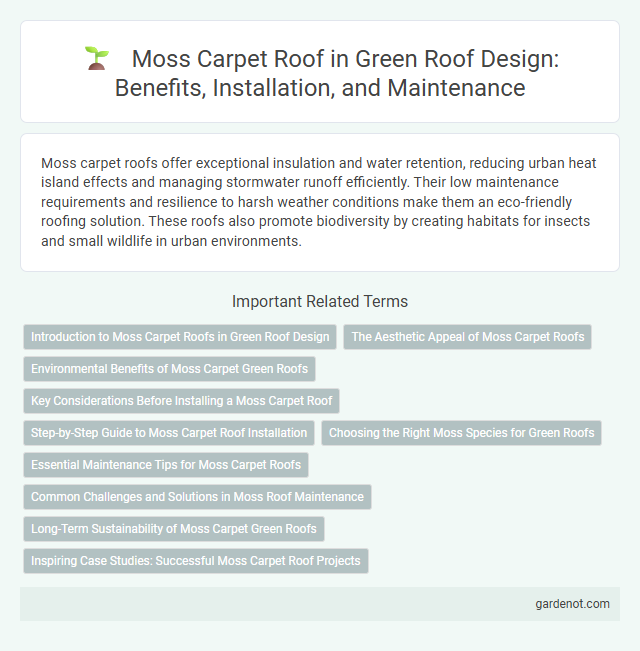Moss carpet roofs offer exceptional insulation and water retention, reducing urban heat island effects and managing stormwater runoff efficiently. Their low maintenance requirements and resilience to harsh weather conditions make them an eco-friendly roofing solution. These roofs also promote biodiversity by creating habitats for insects and small wildlife in urban environments.
Introduction to Moss Carpet Roofs in Green Roof Design
Moss carpet roofs offer a lightweight, low-maintenance alternative in green roof design, thriving in shaded and moist environments where traditional vegetation may struggle. This green roofing solution improves insulation, enhances biodiversity, and helps manage stormwater runoff by absorbing and retaining rainwater. Its ability to establish quickly with minimal substrate depth makes moss carpet roofs ideal for urban settings seeking sustainable and resilient building practices.
The Aesthetic Appeal of Moss Carpet Roofs
Moss carpet roofs offer a unique aesthetic appeal by providing a lush, vibrant green surface that enhances building facades with natural textures and colors. Their soft, dense growth creates a visually soothing environment while blending seamlessly with surrounding landscapes. This living roof option not only beautifies urban spaces but also contributes to biodiversity and natural habitat creation.
Environmental Benefits of Moss Carpet Green Roofs
Moss carpet green roofs provide exceptional environmental benefits, including enhanced air quality through natural pollution filtering and carbon sequestration. Their high moisture retention capacity reduces urban heat island effects by cooling the surrounding air and managing stormwater runoff, preventing soil erosion and water pollution. These roofs also support biodiversity by creating habitats for various microfauna, contributing to urban ecosystem resilience.
Key Considerations Before Installing a Moss Carpet Roof
Moss carpet roofs require careful assessment of environmental conditions such as shade levels, moisture availability, and substrate compatibility to ensure healthy growth and durability. Selecting the right moss species adapted to local climate enhances the roof's insulation and water retention capabilities, reducing maintenance needs. Proper structural support and waterproofing layers are critical to prevent damage and support the weight of the moss carpet over time.
Step-by-Step Guide to Moss Carpet Roof Installation
Start moss carpet roof installation by preparing the roof surface, ensuring it is clean, waterproof, and properly insulated to support plant growth. Lay a moisture-retentive substrate such as a blend of soil, sphagnum moss, and organic materials to promote healthy moss establishment. Carefully place pre-grown moss mats or spores, maintaining adequate moisture and shade during the initial weeks for optimal moss rooting and coverage.
Choosing the Right Moss Species for Green Roofs
Selecting the right moss species for a green roof involves considering factors such as climate adaptability, moisture retention, and growth rate to ensure long-term sustainability. Species like Bryum argenteum and Hypnum cupressiforme are popular for their resilience in urban environments and ability to form dense, insulating carpets. Proper species selection enhances the green roof's biodiversity, thermal regulation, and stormwater management capabilities.
Essential Maintenance Tips for Moss Carpet Roofs
Regular watering and gentle brushing prevent moss carpet roofs from drying out and accumulating debris, ensuring healthy growth. Removing fallen leaves and debris promptly reduces the risk of mold and promotes proper air circulation. Inspecting for signs of damage or thinning helps address issues early, maintaining the roof's insulation and aesthetic benefits.
Common Challenges and Solutions in Moss Roof Maintenance
Moss carpet roofs often face challenges such as moisture retention leading to structural damage and invasive moss growth compromising roof integrity. Effective solutions include regular trimming to control thickness, ensuring proper drainage to prevent waterlogging, and applying anti-fungal treatments to inhibit unwanted growth. Routine inspections help identify early signs of decay or moss overgrowth, maintaining both the aesthetic and functional benefits of a moss roof.
Long-Term Sustainability of Moss Carpet Green Roofs
Moss carpet green roofs enhance long-term sustainability by promoting water retention, reducing urban heat island effects, and requiring minimal maintenance compared to traditional green roofs. Their shallow substrate and low nutrient needs enable survival in harsh climates while supporting biodiversity and improving air quality. Studies show moss green roofs can last over 30 years with proper initial installation and periodic inspections, offering durable, eco-friendly solutions for urban environments.
Inspiring Case Studies: Successful Moss Carpet Roof Projects
Moss carpet roofs have transformed urban spaces by providing sustainable green roofing solutions that enhance biodiversity and insulation. Notable projects like the Bosco Verticale in Milan and the Singapore Sports Hub showcase moss carpets improving air quality while reducing heat island effects. These inspiring case studies demonstrate moss carpet roofs' effectiveness in urban greening and ecological resilience.
Moss carpet roof Infographic

 gardenot.com
gardenot.com